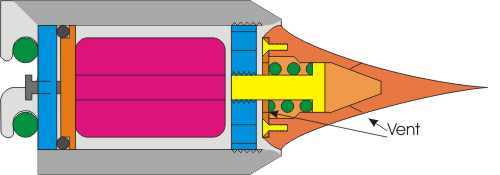Automatic
reloading solid fuel rocket.
Copy write 2004 by William Arden. Redistribution is allowed provided
that this notice is included
Overview
Phase 1
Rocket
Test 1 Smokeless powder and pressure regulator
1
Overview
Rocket efficiency increases with higher pressures,
however
this requires stronger casings. This means that it would be better to
have a
small casing and load more fuel into the rocket as it is used.
The concept is to make one small engine and load individual grains into
it while it fly's. I know this has been tried before, however I plan on
combining several different concepts. Each grain would burn for 1-3
seconds and then
a small motor will breach load a new grain. The thrust of the engine
would then cause the fuel grains to move down the tube and small flaps
would prevent them from moving back up the tube as the shuttle moves
back.
Next I want to explore high pressure engines since the chamber is
so small a high pressure can be handled without making it very heavy.
The only problem is "detonation". I plan on making an automatically
adjusting aerospace engine to control the pressure as the fuel
increases it's burn rate.

Click for a larger
image.
The fuel pellet would have a hole in the center
and would burn on both the outside and the inside.
A small amount of heat sensitive starter material would be
added to the end of the pellet.
Ablative coatings would prevent the shell from overheating.
Pros: higher thrust.
Cons: More complex, changes balance point.
Rocket
Test 1 Smokeless powder and pressure regulator
This first test is designed to test the
pressure regulator to see if it
can regulate the pressure at a specific point regardless of the fuel's
burn rate.
The feedback control mechanism must be stable to prevent oscillations,
however there are two factors working against it.
- The mass of the valve causes a small delay, which will make it
oscillate at some frequency.
- The fuel burn rate increases with pressure so that when the
pressure is too high it will get higher.
- Opening the valve will temporally increases thrust, which will
apply more force to the assembly.
To overcome these a mechanism must be added that can change the valve
position based on the rate of change of pressure.

The mechanical version (to the right) works by
allowing some of the high pressure gasses to push a piston, which
reduces the required spring pressure. Then when a pressure change
occurs the small hole prevents the piston from changing pressure and
the valve opens or closes faster.

March 18 2006 update


